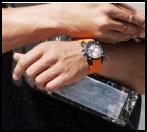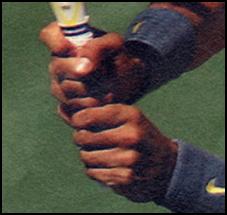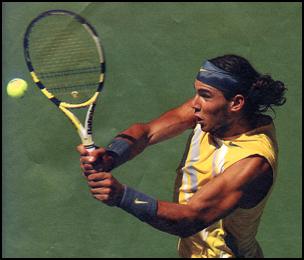Revolutionary Tennis |
||
Tennis Instruction That Makes Sense |
||
HAND USE FOR CONTACT: No twisting. No miss-hits. On purpose.
©2008, Mark Papas Andre Agassi "I take the ball on the rise and play with a lot of wrist." Inside Tennis, Oct/Nov, 2001. Roger Federer serve: "How much you twist your wrist to give it spin and speed and so on." strokes: "[I use] different grips for different shots." To PBS Interviewer Charlie Rose after winning the 2004 U.S. Open. Pancho Gonzalez "You must have a firm grip on the racket when you make contact with the ball." World Tennis magazine, June, 1987. Two facts you're aware of at contact: you get miss-hits, and your racket face often twists in your hand. The same happens to pros, but pros minimize this twisting and dampen the miss-hits. If you can do the same perhaps it's the most direct road to more power and consistency. The racket twists at contact, or oscillates, no matter the grip, the stroke, the stroking style or your physical strength, and you often think it's because you were either late, weak, your hand slipped, you hit off-center or had a bad stroke against your opponent's screamer. You wouldn't be wrong in your thinking but there is a core issue here since it also happens against regular shots and floaters - you know, the easy sitter or high volley you should whack to win, and yet... In addition to vision requirements you have to ask yourself: AT CONTACT: how do I prevent the twisting and stay true through the contact zone? On a subconscious level you know your swing will counter the ball's resistance against the racket (Newton's third law, for every action there is an equal and opposite reaction), and even though the ball's opposite force may not be literally overwhelming this reality adversely affects your swing pattern. Though you can not control physics you need to know how to maintain the integrity of your swing pattern to reduce the twisting and get the best shot possible. To do this like a pro means knowing how to use your hand for, and during, contact. How to do this?
You hold a tennis racket by the handle and swing an area some 20 inches away from the handle to hit the ball. What happens is you either move the hand/palm forward to "hit" the ball as if you were playing handball, move the hand/handle past the ball before contact, or the hand/handle keeps on going forward while the racket face decelerates (goes "backwards") the very first millisecond it hits the ball. When the bottom of the racket (handle) moves faster than, or remarkably ahead of, the top (racket face) at contact the twisting increases because the hand no longer supports or controls the racket face lagging behind.
A top player manages to avoid this twisting of the racket face more often than not, and when at times they don't it's for the same singular reason as you because it happens all too easily. That reason is not so much directly related to the undeniable physics at play, the reason is the pro's hand traveled farther ahead than the racket face either before or during the contact momentS. I say contact momentS because to say contact momenT implies but one moment. The ball is on the strings for 4 milliseconds, sometimes longer. That's at least 4 contact moments, and you can add to that total a few more milliseconds after the ball has left the strings since your response and/or reaction to the physics of contact still influences the racket's forward path for your follow through. High speed contact photos of pros consistently show the hand(s) holding firm while the racket face moves on through the contact, high speed photo shows detail work such as hands, wrist, eyes much better than high speed video. Even taking into account the slight difference in depth of field issues of pro, hand, and racket face these kinds of photographs are both abundant and consistent in what they show. They show the hand firmly around the handle and more in focus than either ball or racket face, you do not see the hand progressing through the shot or farther afield at this moment, and you don't see any finger(s) off the handle; the arms are flexible, faces grimace (except Federer's), strong muscle contractions are visible in one or both arms. Clearly a lot of mental as well as physical effort is being exerted to deliver the shot. Everyone grunt!
AVOID TWISTING: PREPARE YOUR HAND FOR CONTACT
To control the ball better at contact you do not want your hand to move forward during the contact moments, you want the hand to support the racket face. How? By holding on to the handle or firming up the hand for/during contact. Additionally this preserves as much forward racket momentum as possible into the ball during contact's deceleration, keeps the racket head truer in the contact zone during the contact moments, and it keeps your focus where it should be: on the contact and not on the follow through or ball placement. This is also known as firming up the grip for contact, and now you can understand why. This firming up does not mean you start holding the racket with a firm grip while in the ready position, it doesn't mean you hold the racket in a death grip while moving to the ball, it also does not mean locking, or keeping rigid, either arms or wrist. Firming up does not mean you will lose having a flexible, or loose, arm or wrist. Firming up is also referred to as a firm grip, strong grip, strengthening the hand, firming up the wrist, squeezing, resisting - you get the picture. Firming up helps prevent the hand from traveling past the contact spot faster than, and ahead of, the racket face.
Bracing your hand for contact stops the hand from moving on towards the net during the impact moments when the string bed slows down, without this bracing the hand/handle continues on (and the racket face opens). This does not mean your hand/handle stops-in-its-tracks, no, the stroke continues, the hand/handle moves on, it does not move on ahead of the racket face carelessly. Practice hitting the tape like this to learn how to brace for the impact, but please drape a small towel over the tape to protect it while you whack it. I know this is a simplistic example, but it illustrates what is going on with a pro's hand for impact. This simple understanding is often lost in the noise proselytizing the grip must be loose during contact since both wrist and arm are flexible/ loose at contact. And these noisemakers explain the grip firms up "naturally" or "involuntarily" at contact so you don't lose hold of the loosely-gripped racket at contact. Their thesis is a firm grip can not exist with a loose, flexible wrist. Of course it can. More later.
If you brace your hand for contact your shot will immediately improve in quality, sound, and power. If you know to brace you'll do it easily prior to the contact, your hand firms up, squeezes, strengthens for the impact, and at the same time both your wrist and arm will remain loose, flexible, and strong. After contact the grip loosens, the hand and fingers relax (twirling the racket anyone?), and when the ball is returned you go through it all over again. If the ball sails on you or you miss-hit try to recall whether or not you braced for the impact, whether or not your hand traveled further afield too much. Another little tidbit in all of this is how the racket face rises higher or lifts more than the hand during execution. The two photos here illustrate the racket face first below the contact spot and how it rises, or lifts, low-to-high. But the racket head lifts more than the hand, the hand does not lift up equally or in unison with the racket face. It's as if the hand were in the middle of a clock face to some degree and the racket face was one of the clock hands moving up clockwise or counterclockwise.
THE HIGH VOLLEY The difficulty with the high volley can now be appreciated. We either hit the ball down into the net or the ball sails. The ball will go down if we hit too early, either because we stop too soon, or "extend" and hit out in front too literally (and too early), or don't look for the contact from behind the racket face. Solution: wait to hit, patience, let the ball come in a bit more. When the ball sails the racket face was angled back because the hand/handle was shoved forward at the expense of the racket face. In our zeal to smack that high volley our hand just loves to move faster than, and ahead of, the racket face at contact. Solution: don't over"punch" on the ball, stop the hand from moving forward during the "punch." And now the obfuscation begins, this is where this little paper opens up. You don't have to keep on reading to gain the benefit outlined above.
A FIRM GRIP? A LOOSE WRIST? VOLUNTARY OR INVOLUNTARY? Dr. Stanley Plagenhoef, author of Fundamentals Of Tennis, 1970, and our second tennis scientist of note after J. Parmly Paret, says in his book's first sentence: "The firmness of the grip at impact is the single most important factor in hitting a tennis ball." In fact he showed with force-transducer tests in the 1960s grip firmness before, during, and slightly after impact on groundies and right at impact on the serve (but I don't have that paper, just a reference to it). Since Plagenhoef a lot of studies have been done confirming grip firmness translates into the ball rebounds off a racket with higher velocity vs. a grip that is less firm. Should be no problem, right? Problem is either Plagenhoef or someone else bought into the idea the hand's firming of the grip was an involuntary act. In other words just like your heart beating or your lungs breathing (which you can stop, but then need to use again) grip firmness is seen as involuntary. Since then tennis scientists and video analysts inform the tennis public grip firmness happens "naturally." Everyone knows if the grip is loose-loose the racket can fly out of your hand or twist too much on contact. In order to avoid either the tortuous twisting or the devastating destruction of your tennis racket today's scientists and analysts explain the grip tightens for contact involuntarily. But there is a huge problem with this singular involuntary act in a field of voluntary ones. These same scientists and analysts look at video of the pros and ask you to perform certain movements to match what they see on the video (e.g. turn shoulders, tuck elbow in, extend the butt cap or palm to the ball, extend the elbow or turn the arm or lift the triceps up to the ball). While you are asked to swim in this ocean of voluntary movements the tightening of the grip is involuntary? There is yet more spin. The pronation seen on the forehand has been either A), a voluntary choice made by the pro after contact, or B), an involuntary one as a release of natural forces. On the serve you are told the pro's loose grip is voluntary and pronation is also voluntary (because it's necessary). So I have involuntary grip firmness responsible for either a voluntary or involuntary effect on my groundstrokes and a voluntary grip for a voluntary effect on my serve? Am I the only one who says there is something wrong with this logic? Those who claim a loose grip for contact do so to match what they see before and after contact, that is a loose wrist and a flexible arm (extension then flexion to a neutral position to pronation and deviation, or supination to extension and deviation). They can not fathom the grip can be firm and the pro still retains a flexible arm and a loose wrist. It is their lack of experience. From Pancho Gonzalez, World Tennis magazine, 6/1987: "Hold your racket firmly enough so that someone can't pull it out of your hand.... The hand gradually firms up to and through the point of impact... relax after you have made the shot.... Remember: You must have a firm grip on the racket when you make contact with the ball." Serve: "fairly loose throughout the swing... a little tighter [for] ball contact and gradually increase the pressure of holding the racket." Return: "racket should be held more firmly when returning from inside the baseline." Volley: "more firmly because it is a shorter stroke." It may be grip firmness at a lower skill level is involuntary when you're generally unaware of what you are doing, but it becomes more voluntary as you improve and you improve by being aware of it. You learn its benefit as you improve and it happens because it has been both drilled into you and you've learned due to the demand. What would we see in the countless super slow motion videos of tennis pros on YouTube if the hand were strengthless during and after the contact moments? We would see either: In the slow motion videos we see none of that. The hand holds firm throughout the oscillations, the racket face continues on, the ball does not sail. The deduction is there is strength in the hand.
THE GRIP IS FIRM. THE WRIST IS LOOSE.
Question then is: Can we have grip firmness and a loose wrist, grip firmness and a flexible arm? Of course. And that's voluntary. The analysts make their mistake assuming "a minimum amount of grip pressure to control the racquet" at contact is needed to match both a loose wrist and an arm that is not "rigid or locked." That is not the case at all with a top player, or you. At contact you can have a firm grip with both a "relaxed arm" and a wrist however you like. This is how a pro does it.
Many tennis scientists and observationists don't like the idea of the voluntary firm grip since they can't see the hand or wrist doing something during the contact moments as the pros claim. Video watchers divine details from a medium that can neither prove nor disprove this kind of detail yet claim sacred ground absent proof to the contrary. Andre Agassi says he uses "a lot of wrist" on his strokes, and if he voluntarily uses his wrist he voluntarily firms up his grip. Sadly, though, our modern tennis scientists don't help you by explaining how he does this, instead they call him a liar by preaching Agassi has zero degree of wrist displacement on the forward stroke based on the slow motion video they analyze and then they offer their truth as to how he does it. I guess Andre just doesn't know what he's talking about or isn't aware of himself...? You can try this for yourself. Grab the racket handle with your forehand grip, squeeze the grip and keep the racket face perpendicular to the ground. First off you can flex your arm, it remains flexible. Next flex/bend the wrist backwards then forwards. You can't, really. Flexion and extension are difficult when squeezing. Now make the racket edge go up and down, knifing the air. This you can do, it's radial and ulnar deviation in the wrist. Next pronate and supinate the hand, opening and closing the racket face so to speak. This you can do as well. As you can see grip firmness coexists with arm flexibility and wrist movement of the pronation/supination, ulnar/radial deviation kind.
Is it possible to think Nadal's hands above are not squeezing the handle, that only his arms flex and his hands are not firm? Even when his pinkie finger shows stress? Is it possible to think this act is involuntary on his part? Neither sound minds nor experienced players would think so. Compare his left hand when calm and holding a trophy, top right. When we take the racket back we don't squeeze the handle because we first will extend our wrist backwards at some point before dropping the racket face into the forward swing. When dropping the racket we are squeezing the handle and though our wrist flexes (or extends) forward a bit at this point we mostly engage the ability to pronate, supinate, deviate. Trust your instincts, tennis is simpler than what you've been told. I grant you it can be difficult to do because it requires both physical and mental exertion and you repeat things over and over again within changing circumstances, but it's simpler to do than what you've been told.
Tennis is not rocket science. Video simply shows you a look. Not how it was done or why. Video analysts imitate the look or effect. And not the principle.
[Photo credits: Federer, TENNIS magazine, 7/05, AP Photo/Mark J. Terrill; Capriati, TENNIS magazine, 1-2/04, Toru Yamanaka/AFP/Getty Images; Sharapova, LA Times, 6/04/07, Francois Mori/AP; Nadal, TENNIS magazine, 11-12/06, Clive Brunskill/Getty Images; Gonzalez, Inside Tennis, 3/07, Getty Images; Roddick TENNIS magazine, 5/07, Getty Images; Agassi, TENNIS magazine, 5/94, Stephen Szurlej/Tennis Magazine; Federer loose grip, USTA magazine, Sept./Oct. 07, Mary Schilpp, Getty Images.] |
||
|
|
||||||||||||||||||||||||||||||||||||||||||||||||||||||||||||||
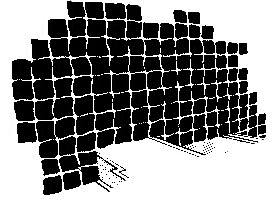
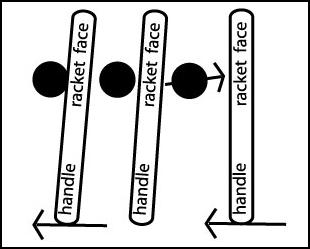
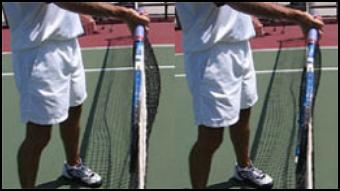 The two photos on the right of me hitting the white tape that represents the contact moment are real-time stills taken off a QuickTime movie. On the left is contact against the ball when I hit the tape, and on the right when the hand continues past the tape the racket face can no longer hold true within the contact zone.
The two photos on the right of me hitting the white tape that represents the contact moment are real-time stills taken off a QuickTime movie. On the left is contact against the ball when I hit the tape, and on the right when the hand continues past the tape the racket face can no longer hold true within the contact zone.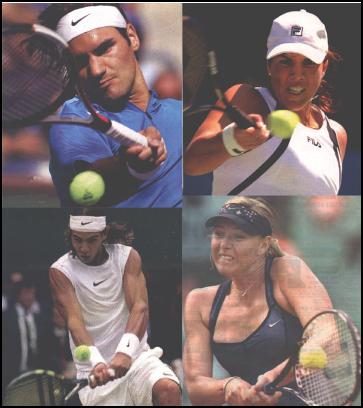
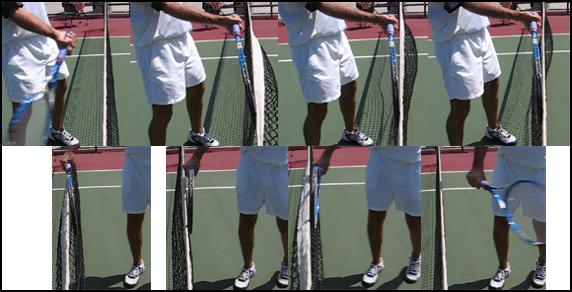 To illustrate, the following stills show me swinging as hard as I can into the tape that represents the contact moment or contact spot. The racket face whacks the tape but my hand stops short of the tape and a gap remains (as illustration). My hand braces for impact, or resists, to maintain racket momentum and stability during contact, my hand does not move on forward ahead of the racket. [Last photo backhand left side shows hand not bracing but continuing.]
To illustrate, the following stills show me swinging as hard as I can into the tape that represents the contact moment or contact spot. The racket face whacks the tape but my hand stops short of the tape and a gap remains (as illustration). My hand braces for impact, or resists, to maintain racket momentum and stability during contact, my hand does not move on forward ahead of the racket. [Last photo backhand left side shows hand not bracing but continuing.]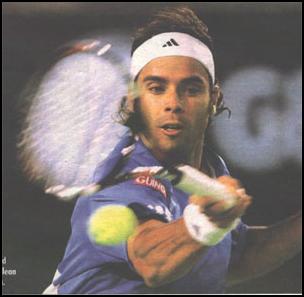 Using a more western grip, or when hitting inside-out to the opposite court or up the line, the hand during the contact moments when viewed from the side can be seen, and is, on the same horizontal plane or even ahead of the racket. These examples make it easier for the hand to move on forward too much too quickly and underscore the greater need to brace for impact to help control the shot. No wonder you lose control on the inside-out shot, no wonder you lose control when hitting late on purpose.
Using a more western grip, or when hitting inside-out to the opposite court or up the line, the hand during the contact moments when viewed from the side can be seen, and is, on the same horizontal plane or even ahead of the racket. These examples make it easier for the hand to move on forward too much too quickly and underscore the greater need to brace for impact to help control the shot. No wonder you lose control on the inside-out shot, no wonder you lose control when hitting late on purpose.
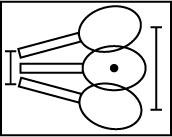
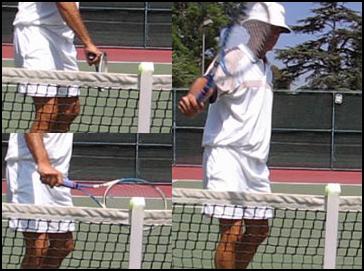
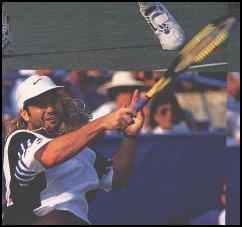
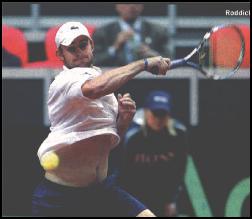 After contact the racket head remains blurry while the hand doesn't, as Agassi and Roddick show here, because the racket head is traveling faster than the hand. And if the hand is not holding firm quite obviously the racket flies out of there and hits a line judge. (Mac would like that.)
After contact the racket head remains blurry while the hand doesn't, as Agassi and Roddick show here, because the racket head is traveling faster than the hand. And if the hand is not holding firm quite obviously the racket flies out of there and hits a line judge. (Mac would like that.)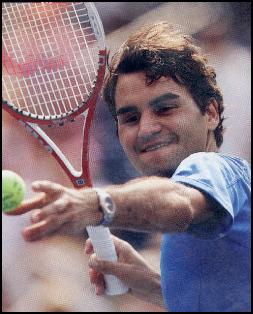 Federer on the right shows what a loose grip looks like on the racket handle, the photo catches him changing his grip to hit a ball into the stands celebrating a victory. The thumb is straight and not wrapped around, his bottom two finger tips are off the handle.
Federer on the right shows what a loose grip looks like on the racket handle, the photo catches him changing his grip to hit a ball into the stands celebrating a victory. The thumb is straight and not wrapped around, his bottom two finger tips are off the handle.